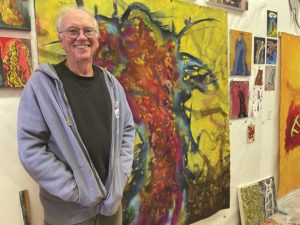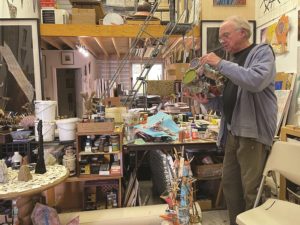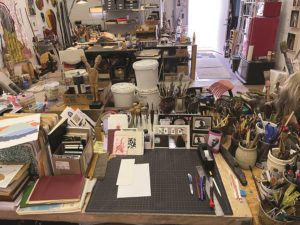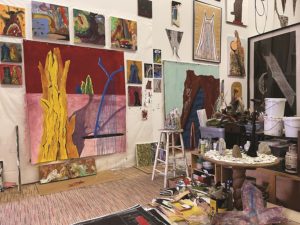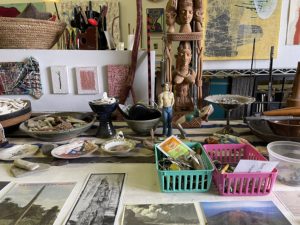Minimalism has grown increasingly popular in recent years, while messiness has been declared an obstacle to productivity. But artists were never ones to submit to rules or trends, and they’re often beset with stuff.
The Independent visited the studios of four artists to get a picture of how they organize their spaces for a productive creative life. Does a messy space generate more ideas than a tidy one? Or does a neat, orderly studio provide the necessary freedom to create?
Bert Yarborough
Bert Yarborough’s warehouse studio is in an industrial complex in Truro. The walls are covered in paintings that climb up to the 30-foot ceiling. “Everything I’ve done that I haven’t sold or parted with is here,” he says. “It’s 50 years of work.”
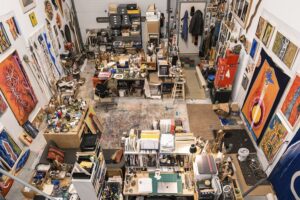
Visitors to the studio can look through the visual archive and see decades-old pieces that might otherwise be out of sight, out of mind. The archive serves him as well. “The visual language that I currently employ,” Yarborough says, “is echoed and reflected off of the older work.”
Despite the amount of art in the space, Yarborough says he’s on the neat side of the messy-tidy spectrum. “I have so much stuff,” he says. “If I don’t keep it reasonably organized, I’d spend an inordinate amount of time looking for things.”
As to whether the crowded nature of the walls is inspiring or detrimental to his artistic process, Yarborough says, “I have no choice.” He has no other way of storing his work. The jumble is “a necessity,” he says, “but I’ve tried to make the necessity work for me.”
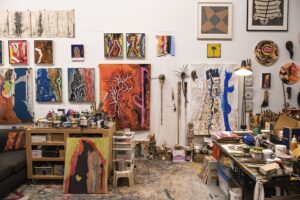
Though the studio is neatly compartmentalized into an office space, storage spaces, and work spaces, Yarborough will soon face the dilemma of where he’ll hang his art. The only empty spot is the ceiling, which he “can’t quite get to,” he says. “If I can stay alive and keep working, I might start stacking it up around me.”
More space would be a luxury, he says. “But as it stands, I’m extremely fortunate to have what I have.”
Janice Redman
Janice Redman, a sculptor who works in a small studio in her Truro home, recently painted the floor and walls white. “I’ve always painted my studio floors white,” Redman says. “It’s like a blank sheet of paper.”
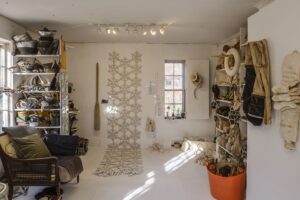
As she makes her art, she eventually gets to a point of chaos. “Things got really unruly” just a couple of days ago, Redman says. “The floor was dirty — there were too many memories of other things.” That’s when she put everything away and repainted the floors.
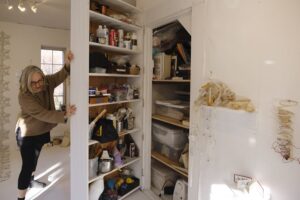
Her space is never “over-the-top neat,” Redman says. But she prefers a room that isn’t overwhelming. “There was no way I could do anything with my frontal lobe in here. I needed to be able to see and think clearly.”
Rob DuToit
Rob DuToit, a painter who is married to Janice Redman, works in a “rhomboid-shaped” Provincetown studio. The walls all lean at angles, so he’s installed his own interior walls, perpendicular to the floor. “Painters have to have flat walls,” DuToit says.
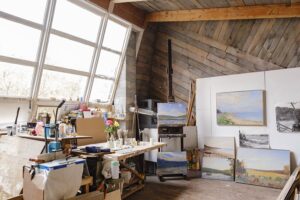
Half of the stuff in his studio is for his frame shop, which “totally overwhelms everything in the summer,” he says. During the winter, he pushes it aside so that he can paint. When the paintings start piling up, he also pushes those to the side. His strategy — one of ordered chaos — involves a “separation of powers” in the studio, with different sections for framing, woodworking, and painting.
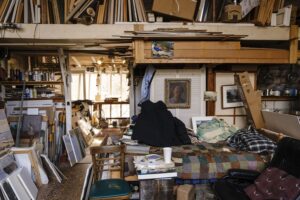
Ultimately, it’s not the inside of the studio that inspires him. “The amazing thing in here is the light,” DuToit says. Light pours into the space through a large slanted window. “On the cloudiest, darkest day, you can work in here,” he says. “It’s always got light.”
Romolo Del Deo
Romolo Del Deo, a Provincetown sculptor, makes his art in a large barn that he built in 2015. He wanted the space to be open and unobstructed in the middle so he could move far away from the project he was working on. “Seeing it from a distance,” he says, “is how you knock sense into yourself while you’re working.”
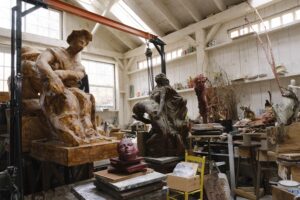
He works with clay, wax, bronze, and marble. The materials make “prodigious amounts of different kinds of dust,” Del Deo says. “Each is incompatible with the others.” Silica dust. Plaster dust. Metal dust. The barn is separated into sections where he works with each material so that the dust doesn’t cross-contaminate.
“I wouldn’t say its super organized,” Del Deo says of his studio. “But there’s a drawer for everything.” When you’re working, he adds, “you don’t want to spend half an hour searching for the one thing you need.
“I try to have as little in the space as possible,” he says. He keeps only the pieces he’s currently working on — though that can be many at a time. Just as it’s hard for a painter to begin with a blank canvas, it’s hard for Del Deo to create work in a perfectly tidy studio, he says.
“When I built this space, and it was nice and clean, it was a little hard to get started,” he says. “But now it’s a thorough mess, and I go from project to project.”
